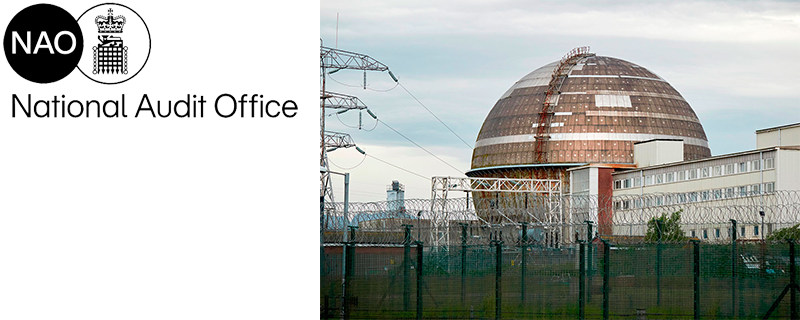Sellafield nuclear site not yet achieving value for money
- Value for money not yet being achieved at Sellafield, with concerns over project management and staffing.
- Management of major projects has begun to improve, but four projects underway when the NAO last reported in 2018 are significantly over budget and behind schedule.
- Sellafield demonstrated for the first time that it can remove its most hazardous waste, but progress isn’t quick enough.
- Please read the report Sellafield 0001 23.pdf
Ongoing concerns over project management, the pace of delivery and staffing at Sellafield – the UK’s most complex and challenging nuclear site – mean it is not yet achieving value for money, a new National Audit Office (NAO) report says.
Sellafield1 is owned by the Nuclear Decommissioning Authority (NDA), an executive non-departmental body sponsored by the Department of Energy Security and Net Zero. The NDA is currently responsible for operating, decommissioning and cleaning up 17 nuclear sites in the UK. Seven more sites are due to be added to its remit.
Sellafield – and the NDA – have made progress on numerous fronts since the NAO last reported on the site in 2018. For the first time, Sellafield safely removed certain types of hazardous waste, including in March 2024 removing a zeolite skip, used to absorb radiation, from the First Generation Magnox Storage Pond (FGMSP).
Separately, the NDA has reorganised itself to address significant contractual, delivery and procurement problems2. Historically, it had contracted out management of nuclear sites to the private sector. The NDA began reversing this trend in 2016 – starting with Sellafield. From 2018-2023 it created a group subsidiary management structure, allowing it to seek savings through economies of scale and improve operational effectiveness, via sharing staff between sites.
Tensions have existed between Sellafield, the NDA and the Office for Nuclear Regulation (ONR). Since 2023, Sellafield’s chief executive and other members of the senior leadership team have left, and there are signs – via staff survey results and willingness by new senior management to confront problems – that the organisation’s culture is improving.
Improving performance culture at Sellafield is key. In 2023, Sellafield paid out £2.1m more in staff bonuses than it should have done – around £200 per person. Its senior management treated one missed target as if it had been met, and omitted another missed target from its assessment of how well the organisation had performed, so the bonus payable was not reduced.
Despite Sellafield demonstrating that it can safely remove the most hazardous material from ageing buildings – which poses an ‘intolerable risk’ – progress isn’t quick enough for it to be able to guarantee that facilities used to treat the waste will reach the end of their useful lives before all the waste is retrieved.
Compared with 2018, milestones for substantially emptying three of the legacy ponds and silos have been pushed back by between 6 and 13 years. Sellafield is hoping to significantly accelerate the pace of retrievals; in the most optimistic scenario, by the mid-2030s it will be retrieving 546 boxes of waste from the Magnox Swarf Storage Silo (MSSS) each year (24 times as much as it did in 2023-24).
Separately, four of the major projects3 the NAO last reported on in 2018 (and which had started construction), are expected to cost £1.15 billion more and be delivered 58-129 months later than previously forecast4. Major projects started more recently are currently in line with their business cases, with one notable exception that is vital to the safe and effective running to the site. This involves Sellafield’s sample analysis facilities4, which are 70 years old and in extremely poor condition.
Work to replace Sellafield’s sample analysis facilities begun in 2016, with Sellafield deciding to convert another laboratory on the site; but work was paused more than seven years after work began and at an already incurred cost of £265m. A refurbishment of the existing sample analysis facility is now the preferred option, but Sellafield cannot yet confirm the viability of this decision5.
Recruitment concerns are hampering Sellafield’s approach to improving cyber security following the site’s prosecution for related breaches/failings earlier this year. Like other areas of the civil service, it faces an increasing threat amid the challenge of recruiting people with the skills it needs.
Future asset management challenges arise from poor data, as Sellafield doesn’t know how long key assets will need to remain operational, nor how long they are likely to last.
Staffing challenges remain, and Sellafield is developing a workforce plan to address issues which have affected operations in recent years. In October 2023, the Sellafield board decided to prioritise addressing workforce capability above achieving commitments made to HM Treasury at the Spending Review 2021. The decision followed Sellafield’s safety assurance team, in 2022, expressing serious concerns about the workforce’s capability to safely operate facilities and maintain assets. The site depends upon a highly skilled workforce, and faces increasing competition from civil and military nuclear programmes.
Gareth Davies, head of the NAO said:
“The NDA needs to build new facilities to treat and store different types of nuclear waste, while maintaining ageing facilities and associated infrastructure until they can be decommissioned.
“Despite progress achieved since the NAO last reported, I cannot conclude Sellafield is achieving value for money yet, as large projects are being delivered later than planned and at higher cost, alongside slower progress in reducing multiple risks.
“Continued underperformance will mean the cost of decommissioning will increase considerably, and ‘intolerable risks’ will persist for longer.”







Leave a Reply
Want to join the discussion?Feel free to contribute!